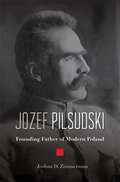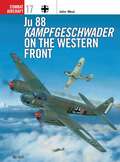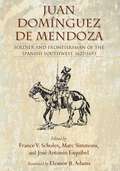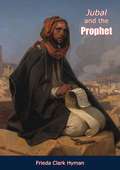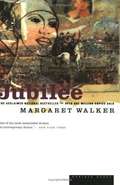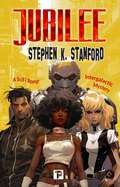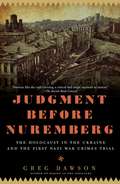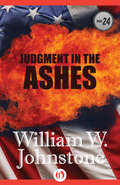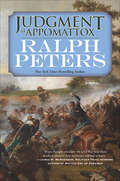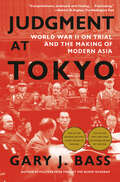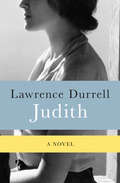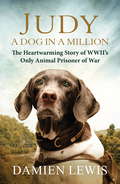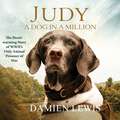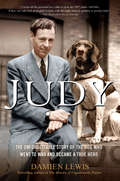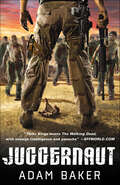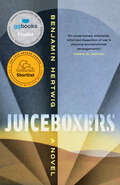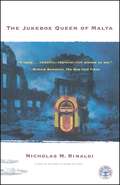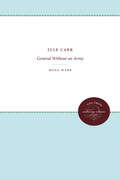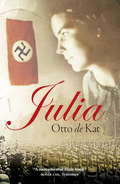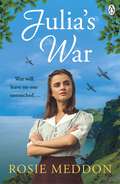- Table View
- List View
Jozef Pilsudski: Founding Father of Modern Poland
by Joshua D. ZimmermanThe story of the enigmatic Jozef Pilsudski, the founding father of modern Poland: a brilliant military leader and high-minded statesman who betrayed his own democratic vision by seizing power in a military coup. In the story of modern Poland, no one stands taller than Jozef Pilsudski. From the age of sixteen he devoted his life to reestablishing the Polish state that had ceased to exist in 1795. Ahead of World War I, he created a clandestine military corps to fight Russia, which held most Polish territory. After the war, his dream of an independent Poland realized, he took the helm of its newly democratic political order. When he died in 1935, he was buried alongside Polish kings. Yet Pilsudski was a complicated figure. Passionately devoted to the idea of democracy, he ceded power on constitutional terms, only to retake it a few years later in a coup when he believed his opponents aimed to dismantle the democratic system. Joshua Zimmerman’s authoritative biography examines a national hero in the thick of a changing Europe, and the legacy that still divides supporters and detractors. The Poland that Pilsudski envisioned was modern, democratic, and pluralistic. Domestically, he championed equality for Jews. Internationally, he positioned Poland as a bulwark against Bolshevism. But in 1926 he seized power violently, then ruled as a strongman for nearly a decade, imprisoning opponents and eroding legislative power. In Zimmerman’s telling, Pilsudski’s faith in the young democracy was shattered after its first elected president was assassinated. Unnerved by Poles brutally turning on one another, the father of the nation came to doubt his fellow citizens’ democratic commitments and thereby betrayed his own. It is a legacy that dogs today’s Poland, caught on the tortured edge between self-government and authoritarianism.
Ju 88 Kampfgeschwader on the Western Front
by John WealUndoubtedly the most versatile German aircraft of World War II (1939-1945), the Junkers Ju 88 served as a fighter, bomber and patrol aircraft on every front on which the Luftwaffe fought. Blooded in action during the Blitzkrieg, the Ju 88 soon proved to be a formidable opponent for the beleaguered Allied air forces. This book is the first of three volumes which will cover the Ju 88's extensive wartime service in the bomber role, and it details the aircraft's early campaigns, through to its extensive use in the night Blitz of 1940-41.
Juan Domínguez de Mendoza: Soldier and Frontiersman of the Spanish Southwest, 1627–1693 (Coronado Historical Series)
by France V. Scholes, Marc Simmons, and José Antonio EsquibelStudies of seventeenth-century New Mexico have largely overlooked the soldiers and frontier settlers who formed the backbone of the colony and laid the foundations of European society in a distant outpost of Spain's North American empire. This book, the final volume in the Coronado Historical Series, recognizes the career of Juan Domínguez de Mendoza, a soldier-colonist who was as instrumental as any governor or friar in shaping Hispano-Indian society in New Mexico. Domínguez de Mendoza served in New Mexico from age thirteen to fifty-eight as a stalwart defender of Spain's interests during the troubled decades before the 1680 Pueblo Revolt. Because of his successful career, the archives of Mexico and Spain provide extensive information on his activities. The documents translated in this volume reveal more cooperative relations between Spaniards and Pueblo Indians than previously understood.
Jubal and the Prophet
by Frieda Clark Hyman Bernard KrigsteinJubal is the son of an important priest in the First Temple; the prophet is Jeremiah; and the time is Jerusalem under siege by the Babylonian Army. Jubal’s father leads the struggle against Babylon. Jeremiah pleads for submission to Babylon.Jubal, of course, would rather follow his father, but in spite of this natural desire, he is convinced by the message and personality of Jeremiah. His struggles lead him directly into adventure. With his friend Ezra he outwits the commander of the gates of Jerusalem, the jailer who would torture the prophet, and then this boy of courage and wisdom fights heroically in the final battle.All this, and more is the theme of the book, a story that is filled with constant action, colorful background and human as well as spiritual emotion.“Jeremiah was the most disquieting of all the prophets. To this day there are some who call him traitor. If, however, a prophet is—as I believe he is—God’s instrument, a man who speaks because a Power greater than he compels him to speak, there can be no question about Jeremiah’s integrity. Nevertheless, the human being is also present; and it is the tension between the prophet’s function as God’s mouthpiece, and his humanity as a patriot, that constitutes the theme of this book: he must condemn his people and his country even while he loves them.”—Frieda Clark Hyman
Jubilee
by John BrickAfter working a year in the War Department, following graduation from West Point, Jeff Barnes returns home to accept leadership of a volunteer regiment in his home town. Then, he finds that he has been superseded by a local politician but he agrees to be second in command, after learning that he will have total charge of training the companies. Shortly after his return, he hastily marries Kate, but their happiness is short-lived. His family and in-laws don't understand his refusal to promote his brother and brother-in-law, nor do they understand when he refuses to tolerate his brother-in-law's illegal activity, brought about because of gambling debts. The pressures of the Civil War change Jeff and place great strain on his marriage and family. Kate does not understand his leaving her and their dying baby to oversee his regiment's transfer to Tennessee. One of his commands results in his brother's suicide. The recruits generally don't like him. The soldiers appreciate his hard training after they begin fighting . At first they are part of the Army of the Potomac, but are transferred to the west under General W. T. Sherman. The Westerners make fun of all Eastern soldiers and brawls are a common occurrence. When Jeff loses an arm from a wound in a battle at Lookout Mountain, Kate does her best to help, but she can't overcome his depression. He thinks it is his duty to resign and get a desk job in Washington, but General Sherman, thanks to Kate's intervention, has other ideas. There are other stories interweaving with Jeff's. One is of an officer who loves Kate. Another is of a very homesick farm boy who sends a woman and her small son home to his father. There is a would-be bounty hunter who has killed his wife and her lover. ... There are a few more. Those who are still left by the time Atlanta falls follow Sherman on his march to the sea.
Jubilee
by Margaret WalkerHistorical novel exploring the struggles of a Black family freed from slavery in Civil War era Georgia..
Jubilee
by Stephen K. StanfordIt was meant to be an in and out mission…Jubilee is a lawless, artificial world existing within its own parallel universe; a seething cesspool of vice ruled by an eccentric AI.So they say.Detectives Col and Danee are sent to Jubilee on a hastily organised mission to recover the body of a leading conservative politician (someone it seems, has been a naughty boy). But the corpse has been switched and the imperilled partners are drawn together. They might be falling in love, or they might be saving the galaxy – either way the authorities will not be pleased.FLAME TREE PRESS is the imprint of long-standing Independent Flame Tree Publishing, dedicated to full-length original fiction in the horror and suspense, science fiction and fantasy. The list brings together fantastic new authors and the more established; the award winners, and exciting, original voices. Learn more about Flame Tree Press at www.flametreepress.com and connect on social media @FlameTreePress
Judges, Law and War: The Judicial Development of International Humanitarian Law
by Shane DarcyInternational courts and judicial bodies play a formative role in the development of international humanitarian law. Judges, Law and War examines how judicial bodies have influenced the substantive rules and principles of the law of armed conflict, and studies the creation, application and enforcement of this corpus of laws. Specifically, it considers how international courts have authoritatively addressed the meaning and scope of particular rules, the application of humanitarian law treaties and the customary status of specific norms. Key concepts include armed conflicts and protected persons, guiding principles, fundamental guarantees, means and methods of warfare, enforcement and war crimes. Consideration is also given to the contemporary place of judicial bodies in the international law-making process, the challenges presented by judicial creativity and the role of customary international law in the development of humanitarian law.
Judgment Before Nuremberg: The Holocaust In The Ukraine And The First Nazi War Crimes Trial
by Greg DawsonFrom the author of Hiding in the Spotlight, the story of the Kharkov trials, forgotten by history, which sought justice for the thousands killed the Ukraine, a place also overlooked in the annals of the Holocaust When one thinks of the Holocaust, we think of Auschwitz, Dachau; and when we think of justice for this terrible chapter in history, we think of Nuremberg. Not of Russia or the Ukraine, and certainly not of a city called Kharkov. But in reality, the first war-crimes trial against the Nazis was in this idyllic, peaceful Ukrainian city, which is fitting, because it is also where the Holocaust actually began.Eighteen months before the end of World War II--two full years before the opening statement by the prosecution at Nuremberg--three Nazi officers and a Ukrainian collaborator were tried and convicted of war crimes and hanged in Kharkov's public square. The trial is symbolic of the larger omission of the Ukraine from the popular history of the Holocaust--another deep irony, as most of the first of the six million perished in the Ukraine long before Hitler and his lieutenant seven decided on the formalities of the Final Solution.
Judgment In the Ashes (Ashes #24)
by William W. JohnstoneFor decades, America has been ravaged by nuclear war, anarchy and disease; now it faces its bloodiest battle yet against the fires of religious intolerance. To millions of men and women, Simon Border is a saint who has the inside track to God. But to Ben Raines, Border is a dangerous hypocrite with an army of true believers who'll do anything they're ordered to do-like go on a holy war against Raines and the SUSA Rebels. Border has condemned Raines as the Antichrist and has vowed to destroy him, his followers and what remains of America. As the rabid religious leader puts into place the final piece of a chilling plan, Raines is going to need a miracle to stop him-and survive.
Judgment at Appomattox: A Novel (The Battle Hymn Cycle)
by Ralph PetersThe ferocious final weeks of the Civil War come alive in Judgment at Appomattox, the final novel of New York Times bestselling author Ralph Peters's breathtaking, Boyd Award-winning seriesA great war nears its end. Robert E. Lee makes a desperate, dramatic gamble. It fails. Ulysses S. Grant moves. Veteran armies clash around Petersburg, Virginia, as Grant seeks to surround Lee and Lee makes a skillful withdrawal in the night. Richmond falls. Each day brings new combat and more casualties, as Lee’s exhausted, hungry troops race to preserve the Confederacy. But Grant does not intend to let Lee escape...In one of the most thrilling episodes in American history, heroes North and South, John Brown Gordon and Phillip Sheridan, James Longstreet and Francis Channing Barlow, battle each other across southern Virginia as the armies converge on a sleepy country court house.Written with the literary flair and historical accuracy readers expect from Ralph Peters, Judgment at Appomattox takes us through the Civil War’s last grim interludes of combat as flags fall and hearts break. Capping the author’s acclaimed five-novel cycle on the war in the East, this “dramatized history” pays homage to all the soldiers who fought, from an Irish-immigrant private wearing gray, to the “boy generals” who mastered modern war. This is a grand climax to a great, prize-winning series that honors—and reveals—America's past.Battle Hymn CycleCain at GettysburgHell or RichmondValley of the ShadowThe Damned of PetersburgJudgment at AppomattoxAt the Publisher's request, this title is being sold without Digital Rights Management Software (DRM) applied.
Judgment at Tokyo: World War II on Trial and the Making of Modern Asia
by Gary J. BassWINNER OF THE ARTHUR ROSS BOOK AWARD FROM THE COUNCIL ON FOREIGN RELATIONS • ACCLAIMED AS ONE OF THE YEAR&’S 10 BEST BOOKS BY THE WASHINGTON POST • 12 ESSENTIAL NONFICTION BOOKS BY THE NEW YORKER • 100 NOTABLE BOOKS BY THE NEW YORK TIMES • BEST BOOKS BY THE ECONOMIST, FOREIGN AFFAIRS, THE TIMES LITERARY SUPPLEMENT, AND AIR MAIL • 10 ESSENTIAL BOOKS BY THE TELEGRAPH • MARK LYNTON HISTORY PRIZE FINALIST • CUNDILL HISTORY PRIZE FINALIST • BAILLIE GIFFORD PRIZE LONGLIST • THE NEW YORK TIMES BOOK REVIEW EDITORS&’ CHOICE • THE OBSERVER AND THE SUNDAY TIMES BOOK OF THE WEEK • DAUNT BOOKS OF THE YEAR • A landmark, magisterial history of the trial of Japan&’s leaders as war criminals—the largely overlooked Asian counterpart to Nuremberg&“Nothing less than a masterpiece. With epic research and mesmerizing narrative power, Judgment at Tokyo has the makings of an instant classic.&”—Evan Osnos, National Book Award–winning author of Age of Ambition: Chasing Fortune, Truth, and Faith in the New ChinaIn the weeks after Japan finally surrendered to the Allies to end World War II, the world turned to the question of how to move on from years of carnage and destruction. For Harry Truman, Douglas MacArthur, Chiang Kai-shek, and their fellow victors, the question of justice seemed clear: Japan&’s militaristic leaders needed to be tried and punished for the surprise attack at Pearl Harbor; shocking atrocities against civilians in China, the Philippines, and elsewhere; and rampant abuses of prisoners of war in notorious incidents such as the Bataan death march. For the Allied powers, the trial was an opportunity to render judgment on their vanquished foes, but also to create a legal framework to prosecute war crimes and prohibit the use of aggressive war, building a more peaceful world under international law and American hegemony. For the Japanese leaders on trial, it was their chance to argue that their war had been waged to liberate Asia from Western imperialism and that the court was victors&’ justice.For more than two years, lawyers for both sides presented their cases before a panel of clashing judges from China, India, the Philippines, and Australia, as well as the United States and European powers. The testimony ran from horrific accounts of brutality and the secret plans to attack Pearl Harbor to the Japanese military&’s threats to subvert the government if it sued for peace. Yet rather than clarity and unanimity, the trial brought complexity, dissents, and divisions that provoke international discord between China, Japan, and Korea to this day. Those courtroom tensions and contradictions could also be seen playing out across Asia as the trial unfolded in the crucial early years of the Cold War, from China&’s descent into civil war to Japan&’s successful postwar democratic elections to India&’s independence and partition.From the author of the acclaimed The Blood Telegram, which was a Pulitzer Prize finalist, this magnificent history is the product of a decade of research and writing. Judgment at Tokyo is a riveting story of wartime action, dramatic courtroom battles, and the epic formative years that set the stage for the Asian postwar era.
Judith: A Novel
by Lawrence DurrellA breathtaking novel of passion and politics, set in the hotbed of Palestine in the 1940s, by a master of twentieth-century fictionIt is the eve of Britain&’s withdrawal from Palestine in 1948, a moment that will mark the beginning of a new Israel. But the course of history is uncertain, and Israel&’s territorial enemies plan to smother the new country at its birth. Judith Roth has escaped the concentration camps in Germany only to be plunged into the new conflict, one with stakes just as high for her as they are for her people. Initially conceived as a screenplay for the 1966 film starring Sophia Loren, Lawrence Durrell&’s previously unpublished novel offers a thrilling portrayal of a place and time when ancient history crashed against the fragile bulwarks of the modernizing world. This ebook features an introduction by editor Richard Pine, which puts Judith in context with Durrell&’s body of work and traces the fascinating development of the novel. Also included is an illustrated biography of Lawrence Durrell containing rare images and never-before-seen documents from the author&’s estate and the British Library&’s modern manuscripts collection.
Judy: From Runaway Puppy to the World's Most Heroic Dog
by Damien LewisThe impossibly moving story of how Judy, World War Two's only animal POW, brought hope in the midst of hell.Judy, a beautiful liver and white English pointer, and the only animal POW of WWII, truly was a dog in a million, cherished and adored by the British, Australian, American and other Allied servicemen who fought to survive alongside her. Viewed largely as human by those who shared her extraordinary life, Judy's uncanny ability to sense danger, matched with her quick-thinking and impossible daring saved countless lives. She was a close companion to men who became like a family to her, sharing in both the tragedies and joys they faced. It was in recognition of the extraordinary friendship and protection she offered amidst the unforgiving and savage environment of a Japanese prison camp in Indonesia that she gained her formal status as a POW. Judy's unique combination of courage, kindness and fun repaid that honour a thousand times over and her incredible story is one of the most heartwarming and inspiring tales you will ever read.
Judy: From Runaway Puppy to the World's Most Heroic Dog
by Damien LewisThe impossibly moving story of how Judy, World War Two's only animal POW, brought hope in the midst of hell.Judy, a beautiful liver and white English pointer, and the only animal POW of WWII, truly was a dog in a million, cherished and adored by the British, Australian, American and other Allied servicemen who fought to survive alongside her. Viewed largely as human by those who shared her extraordinary life, Judy's uncanny ability to sense danger, matched with her quick-thinking and impossible daring saved countless lives. She was a close companion to men who became like a family to her, sharing in both the tragedies and joys they faced. It was in recognition of the extraordinary friendship and protection she offered amidst the unforgiving and savage environment of a Japanese prison camp in Indonesia that she gained her formal status as a POW. Judy's unique combination of courage, kindness and fun repaid that honour a thousand times over and her incredible story is one of the most heartwarming and inspiring tales you will ever read.
Judy: From Runaway Puppy to the World's Most Heroic Dog
by Damien LewisJudy, a beautiful liver and white English pointer, and the only animal POW of WWII, truly was a dog in a million, cherished and adored by the British, Australian, American and other Allied servicemen who fought to survive alongside her. Viewed largely as human by those who shared her extraordinary life, Judy's uncanny ability to sense danger, matched with her quick-thinking and impossible daring saved countless lives. She was a close companion to men who became like a family to her, sharing in both the tragedies and joys they faced. It was in recognition of the extraordinary friendship and protection she offered amidst the unforgiving and savage environment of a Japanese prison camp in Indonesia that she gained her formal status as a POW. Judy's unique combination of courage, kindness and fun repaid that honour a thousand times over and her incredible story is one of the most heartwarming and inspiring tales you will ever hear.(P) 2014 WF Howes Ltd
Judy: The Unforgettable Story of the Dog Who Went to War and Became a True Hero
by Damien LewisBritish bestselling author Damien Lewis is an award-winning journalist who has spent twenty years reporting from war, disaster, and conflict zones. Now Lewis brings his first-rate narrative skills to bear on the inspiriting tale of Judy--an English pointer who perhaps was the only canine prisoner of war. After being bombed and shipwrecked repeatedly while serving for several wild and war-torn years as a mascot of the World War II Royal Navy Yangtze river gunboats the Gnat and the Grasshopper, Judy ended up in Japanese prisoner of war camps in North Sumatra. Along with locals as slave labor, the American, Australian, and British POWs were forced to build a 1,200-mile single-track railroad through the most horrifying jungles and treacherous mountain passes. Like the one immortalized in the film The Bridge on the River Kwai, this was the other death-railroad building project where POWs slaved under subhuman conditions. In the midst of this living hell was a beautiful and regal-looking liver and white English pointer named Judy. Whether she was scavenging food to help feed the starving inmates of a hellish Japanese POW camp, or by her presence alone bringing inspiration and hope to men, she was cherished and adored by the Allied servicemen who fought to survive alongside her. Judy's uncanny ability to sense danger, matched with her quick thinking and impossible daring saved countless lives. More than a close companion she shared in both the men's tragedies and joys. It was in recognition of the extraordinary friendship and protection she offered amidst the unforgiving and savage environment of a Japanese prison camp in Indonesia that she gained her formal status as a POW. From the author of The Dog Who Could Fly and the co-author of Sergeant Rex and It's All About Treo comes one of the most heartwarming and inspiring tales you will ever read.
Juggernaut
by Adam Baker"A high-voltage shock to the system. It's smart, witty, crammed with action and disturbingly plausible. Highly recommended." –Jonathan Maberry, New York Times bestselling author of Assassin's CodeA brilliant, gripping portrait of survival in the face of complete annihilation. THEY SEARCHED FOR GOLD. THEY FOUND DEATH. Iraq 2005. Seven mercenaries hear an enticing rumor: somewhere, abandoned in the swirling desert sands, lies an abandoned Republican Guard convoy containing millions of pounds of Saddam's gold. They form an unlikely crew of battle-scarred privateers, killers and thieves, veterans of a dozen war zones, each of them anxious to make one last score before their luck runs out. After liberating the sole surviving Guard member from US capture, the team makes their way to the ancient ruins where the convoy was last seen. Although all seems eerily quiet and deserted when they arrive, they soon find themselves caught in a desperate battle for their lives, confronted by greed, betrayal, and an army that won't stay dead. An unputdownable military thriller that SFFworld.com called "Three Kings meets The Walking Dead," Juggernaut is a heart-pounding, fast-paced read that doesn't let up until the last page.
Juiceboxers
by Benjamin HertwigFinalist for the 2025 Governor General's Literary AwardFinalist for the 2025 Amazon Canada First Novel AwardWinner of the Robert Kroetsch City of Edmonton Book PrizeA powerful debut novel about four young soldiers serving in Afghanistan, and the devastating aftermath of war."An unvarnished, intimately informed dissection of war's physical and emotional derangements." – Omar El Akkad, author of What Strange Paradise and American War Sixteen-year-old Plinko is attending basic training before high school starts up again in the fall. Feeling adrift from his own family, he moves in with an older soldier, where he forges an unlikely group of friends in the military: the very tall Walsh, who moves in shortly after Plinko does; Abdi, whose Somali immigrant parents often welcome the group of young men over for dinner; and the unpredictable and gun-loving Krug, who is brash and exasperating yet magnetic. After 9/11, the military prepares to move into Afghanistan — to go to war. Plinko and his friends have no idea that the trajectory of their lives is about to be irrevocably altered. Drawn from the author's experiences as a soldier in Afghanistan, Juiceboxers tenderly traces the story of a young man's journey from basic training, to the battlefields of Kandahar, to the inner city of Edmonton, braiding together questions of masculinity and militarism, friendship and white supremacy, loss and trauma and hard-won recovery.
Jukebox Queen Of Malta: A Novel
by Nicholas RinaldiThe Jukebox Queen of Malta is an exquisite and enchanting novel of love and war set on an island perilously balanced between what is real and what is not. It's 1942 and Rocco Raven, an intrepid auto mechanic turned corporal from Brooklyn, has arrived in Malta, a Mediterranean island of Neolithic caves, Copper Age temples, and fortresses. The island is under siege, full of smoke and rubble, caught in the magnesium glare of German and Italian bombs. But nothing is as it seems on Malta. Rocco's living quarters are a brothel; his commanding officer has a genius for turning the war's misfortunes into personal profit; and the Maltese people, astonishingly, testify to the resiliency of the human spirit. When Rocco meets the beautiful and ethereal Melita, who delivers the jukeboxes her cousin builds out of shattered debris, they are drawn to each other by an immediate passion. And, it is their full-blown affair that at once liberates and imprisons Rocco on the island. In this mesmerizing novel, music and bombs, war and romance, the jukebox and the gun exist in arresting counterpoint in a story that is a profound and deeply moving exploration of the redemptive powers of love.
Jule Carr: General Without an Army
by Mena WebbA UNC Press Enduring Edition -- UNC Press Enduring Editions use the latest in digital technology to make available again books from our distinguished backlist that were previously out of print. These editions are published unaltered from the original, and are presented in affordable paperback formats, bringing readers both historical and cultural value.
Julia
by Otto de KatOne summer's afternoon in 1981, a factory owner, Christiaan Dudok, is found dead in his study having taken his own life. He has left no suicide note, but on his desk is a newspaper from 2 April 1942, reporting on the bombing of the north German town of Lübeck. The list of the dead includes the highlighted name of Julia Bender. As a young man finishing his studies in Lübeck in 1938, Christiaan is irresistibly drawn to Julia, a courageous German who has emphatically rejected the Nazi regime. But that same year he is forced to leave both Germany and the woman he loves, even though he suspects that he is making the greatest mistake of his life .Julia is the story of a life lived wrongly, of a love so great that it endures for decades, and yet still fails. Fear of life and loss of courage, and terrifying inhuman fanaticism are the compelling themes explored in Otto de Kat's elegantly accomplished, elegiac novel.
Julia
by Otto de KatOne summer's afternoon in 1981, a factory owner, Christiaan Dudok, is found dead in his study having taken his own life. He has left no suicide note, but on his desk is a newspaper from 2 April 1942, reporting on the bombing of the north German town of Lübeck. The list of the dead includes the highlighted name of Julia Bender. As a young man finishing his studies in Lübeck in 1938, Christiaan is irresistibly drawn to Julia, a courageous German who has emphatically rejected the Nazi regime. But that same year he is forced to leave both Germany and the woman he loves, even though he suspects that he is making the greatest mistake of his life .Julia is the story of a life lived wrongly, of a love so great that it endures for decades, and yet still fails. Fear of life and loss of courage, and terrifying inhuman fanaticism are the compelling themes explored in Otto de Kat's elegantly accomplished, elegiac novel.
Julia's Story
by Catherine M. RaeHappily married and well off, Julia's life is full of servants, parties, fine clothes and travel. Then her husband dies unexpectedly in a boating accident. Julia is pulled into her parents' financial and mental deterioration when she is forced by economic need to live with them. Their difficulty stems from a missing sum of $100,000 which her father apparently salted away before the crash, and the disappearance of her mother's jewels. Meanwhile, her brothers, saddles with their own individual struggles, show no sympathy toward her widowed and newly dependent status. Finally, Julia finds romance (and tragedy) anew, incredibly making the leap from rags to riches.
Julia's War: A Gripping and Emotional WWII Saga of Love, Loss, and Resilience
by Rosie MeddonWhen War Threatens Home, One Woman Fights to Save Her SanctuaryA sweeping and emotional new saga series from beloved author, Rosie Meddon--Devon, 1939Young widow Julia Nance has finally found happiness running her beloved guest house, Fairlight. But when war breaks out leaving the guest house empty, Julia desperately searches for alternative uses for her home – and a source of income to protect her new life.In wartime things are never straightforward, and when it looks like Julia’s future will rely on the charity of an arch-enemy, it seems like her newfound haven might be lost forever. As invasion looms, she has no choice but to throw herself into saving the village and its locals.The once idyllic Slipscombe Sands is now in peril. Will a surprising wartime calling for her guesthouse bring laughter and noise back to Fairlight? Perfect for fans of Vicki Beeby, Ginny Bell, Nancy Revell and Rosie Goodwin
